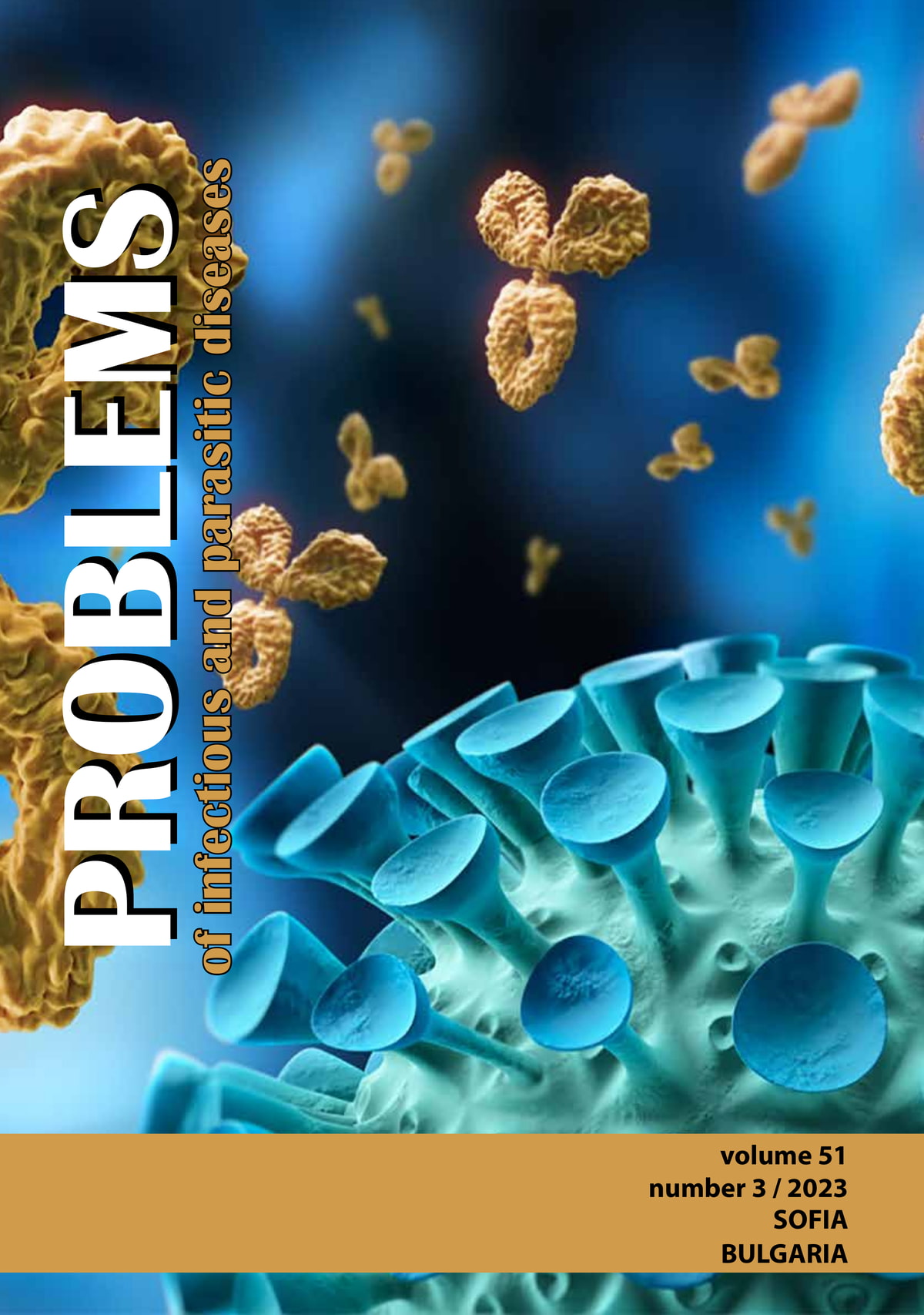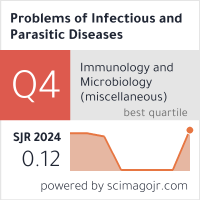FERROPTOSIS IN CD4+ AND CD8+ T-CELLS IN THE SETTINGS OF HIV INFECTION
DOI:
https://doi.org/10.58395/pmgvqy76Keywords:
HIV, ferroptosis, cARTAbstract
Introduction: Elevation of intracellular iron concentration triggers ferroptosis. Understanding the regulation and pathophysiological mechanisms of this process in HIV infection may contribute to antiretroviral therapy (cART) monitoring.
Aim: To perform a correlation analysis of the intracellular labile-bound iron pool (LIP) in CD4+ and CD8+ T cells in association with CD4+, CD8+ T cells absolute count (AC) and CD4/CD8 index in HIV+ individuals on continuous cART with sustained viral suppression.
Material and methods: Peripheral blood samples (Li heparin, n=34) were collected in the course of the routine immune monitoring of HIV+ individuals at four time points during 24 months. Plasma HIV viral load (VL) was determined with the Abbott Real-Time HIV-1 test (sensitivity 40 copies/ml). AC and percentage of CD4+ and CD8+ T cells were determined by direct flow cytometry (Multitest, BD Trucount, FACS Canto II). The intracellular content of LIP in CD4 and CD8 T cells (LIP CD4, LIP CD8) was measured at the beginning of the study, using acetoxymethyl ester and subsequent incubation with a chelator (Deferiprone). LIP was quantified according to the mean fluorescence intensity (MFI) (FACSCanto II, Diva 6.1.2).
Results: In the settings of a higher LIP CD4 , high LIP CD8 correlated with increased CD8AC (Rho=0.70, p<0.05) up to 11 (min. 6, max. 15) months after LIP measurement., and decreased CD4/CD8 ratio correlated inversely with LIP CD8 in all consecutive measurements (Rho= -0.71, p<0.01 for all), Importantly, high LIP CD8 correlated with a lower CD4AC (Rho=-0.65, p<0.05) up to five (min.1, max.8) months after LIP measurement.
Conclusion: The increased concentration of intracellular LIP in CD8 cells in HIV+cART individuals could indicate viral activity in the settings of undetectable HIV VL, directly associated with ongoing cell ferroptosis.
Downloads
References
Nemeth E, Tuttle MS, Powelson J, Vaughn MB, Donovan A, Ward DM, et al. Hepcidin regulates cellular iron efflux by binding to ferroportin and inducing its internalization. Science. 2004; 306:2090-3. https://doi.org/10.1126/science.1104742
Lang X, Green MD, Wang W, et al. Radiotherapy and immunotherapy promote tumoral lipid oxidation and ferroptosis via synergistic repression of SLC7A11. Cancer Discov. 2019; 9(12):1673-1685. https://doi.org/10.1158/2159-8290.CD-19-0338
Feng H, Stockwell BR. Unsolved mysteries: how does lipid peroxidation cause ferroptosis? PLoS Biol. 2018; 16(5):e2006203. https://doi.org/10.1371/journal.pbio.2006203
Amaral EP, Namasivayam S. Emerging Role for Ferroptosis in Infectious Diseases. In: Florez AF and Alborzinia H. Ferroptosis Mechanism and Diseases. Cham Switzerland: Springer 2021. 59-79. https://doi.org/10.1007/978-3-030-62026-4
Cao JY, Dixon SJ. Mechanisms of ferroptosis. Cellular and Molecular Life Sciences. 2016; CMLS, 73(11-12), 2195-2209. doi:10.1007/s00018-016-2194-1. https://doi.org/10.1007/s00018-016-2194-1
Shah R, Shchepinov MS, Pratt DA. Resolving the role of lipoxygenases in the initiation and execution of ferroptosis. ACS Central Science. 2018; 4(3), 387-396. https://doi.org/10.1021/acscentsci.7b00589
Yang WS, Kim KJ, Gaschler MM, Patel M, Shchepinov MS, Stockwell BR. Peroxidation of polyunsaturated fatty acids by lipoxygenases drives ferroptosis. Proceedings of the National Academy of Sciences of the United States of America, 2016; 113(34), E4966-75. https://doi.org/10.1073/pnas.1603244113
Oh SJ, Ikeda M, Ide T, Hur KY, Lee MS. Mitochondrial event as an ultimate step in ferroptosis. Cell Death Discovery, 2022; 8(1), 414. https://doi.org/10.1038/s41420-022-01199-8
Tang D, Kang R, Berghe TV, Vandenabeele P, Kroemer G. The molecular machinery of regulated cell death. Cell Res. 2019;29 (5): 347-364. https://doi.org/10.1038/s41422-019-0164-5
Xu M, Kashanchi F, Foster A, Rotimi J, Turner W, Gordeuk VR, et al. Hepcidin induces HIV-1 transcription inhibited by ferroportin. Retrovirology. 2010; 7:104. https://doi.org/10.1186/1742-4690-7-104
Prus E, Fibach E. Flow Cytometry Measurement of the Labile Iron Pool in Human Hematopoietic Cells. Cytometry 2007; Part A; 73A: 22-27, https://doi.org/10.1002/cyto.a.20491
Emilova R, Manolov V, Todorova Y, Yancheva N, Alexiev I, Nikolova M. Elevated Labile Iron Levels in CD4 and CD8 T Cells from HIV-Positive Individuals with Undetectable Viral Load. AIDS Res Hum Retroviruses, 2020; 36 (7), 597-600. https://doi.org/10.1089/AID.2020.0010
Zhu A, Real F, Zhu J, Greffe S, de Truchis P, Rouveix E, Bomsel M, Capron C. HIV-Sheltering Platelets From Immunological Non-Responders Induce a Dysfunctional Glycolytic CD4+ T-Cell Profile. Front Immunol. 2022; 11;12:781923. https://doi.org/10.3389/fimmu.2021.781923. PMID: 35222352; PMCID: PMC8873581.
Kaufmann GR, Perrin L, Pantaleo G, Opravil M, Furrer H, Telenti A, et al. CD4 T-Lymphocyte Recovery in Individuals With Advanced HIV-1 Infection Receiving Potent Antiretroviral Therapy for 4 Years: The Swiss HIV Cohort Study. Arch Intern Med. 2003; 163(18):2187-95. https://doi.org/10.1001/archinte.163.18.2187
Cao W, Liu X, Han Y, Song X, Lu L, Li X, Lin L, Sun L, Liu A, Zhao H, Han N, Wei H, Cheng J, Zhu B, Wang M, Li Y, Ma P, Gao L, Wang X, Yu J, Zhu T, Routy JP, Zuo M, Li T. (5R)-5-hydroxytriptolide for HIV immunological non-responders receiving ART: a randomized, double-blinded, placebo-controlled phase II study. Lancet Reg Health West Pac. 2023; 34:100724. https://doi.org/10.1016/j.lanwpc.2023.100724; PMID: 37283977; PMCID: PMC10240372.
Stockwell BR, Jiang X, Gu W. Emerging mechanisms and disease relevance of ferroptosis. Trends Cell Biol. 2020; 30(6):478-490. https://doi.org/10.1016/j.tcb.2020.02.009
Silva JP, Coutinho OP. Free radicals in the regulation of damage and cell death-basic mechanisms and prevention. Drug Discov.Ther. 2010, 4: 144-167.
Kodali S, Kafeel M, Naik S, Rathnasabapathy Ch, He Z, Kalavar M, Steir W. Conditions Associated with Hyperferritinemia in HIV Positive Patients. Blood 2007; 110 (11): 2288. https://doi.org/10.1182/blood.V110.11.2288.2288
Emilova R, Todorova Y, Aleksova M, Dimitrova R, Alexiev I, Grigorova L, Yancheva N, Nikolova M. Determination of reactive oxygen species in T-cell subsets of HIV+ patients on continuous cART. Probl Infect Parasit Dis. 2022; 50(1): 5-11. https://pipd.ncipd.org/index.php/pipd/article/view/50-1-1-T-CELL-SUBSETS-OF-HIV-PATIENTS; https://doi.org/10.58395/pipd.v50i1.89
Emilova R, Todorova Y, Aleksova M, Alexiev I, Grigorova L, Dimitrova R, Yancheva, N, Nikolova M,. Reactive oxygen species (ROS) features on T-cell subpopulation in people living with HIV. In: J Int AIDS Soc. 2022; 25 (S6): 194-95.
Chen J, Fu J, Zhao S, Zhang X, Chao Y, Pan Q, Sun H, Zhang J, Li B, Xue T, Li J, Liu C. Free Radical and Viral Infection: A Review from the Perspective of Ferroptosis. Vet Sci. 2023; 10(7):456. https://doi.org/10.3390/vetsci10070456. PMID: 37505861; PMCID: PMC10384322.
Wang M, Joshua B, Jin N, Du S, Li C. Ferroptosis in viral infection: The unexplored possibility. Acta Pharmacol. Sin. 2022; 43, 1905-1915. https://doi.org/10.1038/s41401-021-00814-1
Drakesmith H, Prentice A. Viral infection and iron metabolism. Nat. Rev. Microbiol. 2008; 6, 541-552. https://doi.org/10.1038/nrmicro1930
Nirmala JG, Lopus M. Cell death mechanisms in eukaryotes. Cell Biology and Toxicology. 2020; 36(2): 145-164. https://doi.org/10.1007/s10565-019-09496-2. PMID 31820165. S2CID 254369328.
Miotto G, Rossetto M, Di Paolo ML, Orian L, Venerando R, Roveri A, Vučković AM, Bosello Travain V, Zaccarin M, Zennaro L, Maiorino M, Toppo S, Ursini F, Cozza G. Insight into the mechanism of ferroptosis inhibition by ferrostatin-1. Redox Biol. 2020; 28:101328. https://doi.org/10.1016/j.redox.2019.101328. Epub 2019 Sep 20. PMID: 31574461; PMCID: PMC6812032.
Hao S, Liang B, Huang Q, Dong S, Wu Z, He W, Shi M. Metabolic networks in ferroptosis. Oncology Letters. 2018; 15 (4): 5405-5411. https://doi.org/10.3892/ol.2018.8066; PMC 5844144. PMID 29556292.
Xiao Q, Yan L, Han J, Yang S, Tang Y, Li Q, Lao X, Chen Z, Xiao J, Zhao H, Yu F, Zhang F. Metabolism-dependent ferroptosis promotes mitochondrial dysfunction and inflammation in CD4+ T lymphocytes in HIV-infected immune non-responders. EBioMedicine. 2022; 86:104382. https://doi.org/10.1016/j.ebiom.2022.104382
Downloads
Published
Issue
Section
License
Copyright (c) 2024 Radoslava Emilova, Yana Todorova, Milena Aleksova, Reneta Dimitrova, Lyubomira Grigorova, Damian Vangelov, Ivaylo Alexiev, Nina Yancheva, Maria Nikolova (Author)

This work is licensed under a Creative Commons Attribution 4.0 International License.






